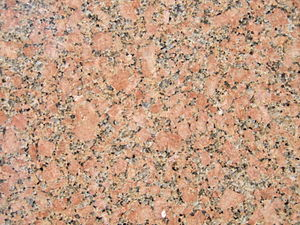- Home
- About US
- Art and Craft
- Artisans
- Master Crafts Persons
- Supporting Institutions
- News and Events
- Schemes
- Contact us
- Contact

Granite is a common type of felsic intrusive igneous rock that is granular and phaneritic in texture. Granites can be predominantly white, pink, or gray in color, depending on their mineralogy. The word "granite" comes from theLatin granum, a grain, in reference to the coarse-grained structure of such a holocrystalline rock. By
definition, granite is an igneous rock with at least 20% quartz and up to 65% alkali feldspar by volume.
The term "granitic" means granite-like and is applied to granite and a group of intrusive igneous rocks with similar textures and slight variations in composition and origin. These rocks mainly consist of feldspar, quartz, mica, and amphibole minerals, which form an interlocking, somewhat equigranular matrix of feldspar and quartz with scattered darker biotite mica and amphibole (often hornblende) peppering the lighter color minerals. Occasionally some individual crystals (phenocrysts) are larger
than the groundmass, in which case the texture is known as porphyritic. A granitic rock with a porphyritic texture is known as a granite porphyry. Granitoid is a general, descriptive field term for lighter-colored, coarse-grained igneous rocks.Petrographic examination is required for identification of specific types of granitoids.
Granite differs from granodiorite in that at least 35% of the feldspar in granite is alkali feldspar as opposed to plagioclase; it is the potassium feldspar that gives many granites a distinctive pink color. The extrusive igneous rock equivalent of granite is rhyolite.
Granite is nearly always massive (lacking any internal structures), hard and tough, and therefore it has gained widespread use throughout human history, and more recently as a construction stone. The average density of granite is between 2.65 and 2.75 g/cm3, its compressive strength usually lies above 200 MPa, and ts viscosity near STP is 3–6 • 1019 Pa·s.
The melting temperature of dry granite at ambient pressure is 1215–1260 °C (2219–2300 °F); it is strongly reduced in the presence of water, down to 650 °C at a few kBar pressure.
Granite has poor primary permeability, but strong secondary permeability.
The rock known as "black granite" is usually gabbro.

